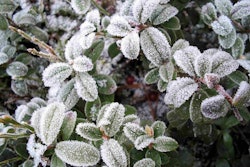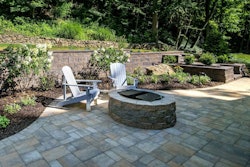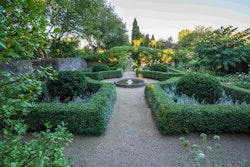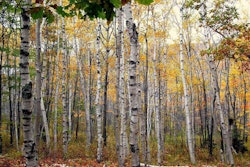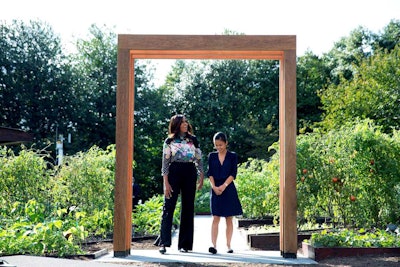 Michelle Obama stands with Tammy Nguyen, a student participating in the first lady’s “Let’s Move!” initiative, beneath a new arbor designed by UVA students for the White House Kitchen Garden.
Michelle Obama stands with Tammy Nguyen, a student participating in the first lady’s “Let’s Move!” initiative, beneath a new arbor designed by UVA students for the White House Kitchen Garden.Photo: White House/Amanda Lucidon
Over the summer, Michelle Obama commissioned a team of faculty members and students from the University of Virginia’s School of Architecture to design a communal table and gathering space for the White House Kitchen Garden.
With the Obamas’ time in the White House drawing to a close, the announcement came recently that the White House Kitchen Garden will become a permanent part of the South Lawn, thanks in part to a $2.5 million donation from The Burpee Foundation. The first lady introduced the kitchen garden in 2009 as part of her “Let’s Move!” initiative, which fights childhood obesity and promotes healthy lifestyles.
The University of Virginia team, led by landscape architecture professor Elizabeth K. Meyer, was tasked with creating garden spaces and structures that encouraged community, as guests visiting the garden range from schoolchildren to dignitaries.
“The first lady was interested in the garden not just as a place to produce food, but as a social space where children and adults can gather to learn something about the relationships between gardening, food and their own health and well-being,” Meyer told UVAToday.
Meyer is accustomed to working with some of Washington’s most well-known landmarks, having served as an adviser for the design competitions held by The Trust for the National Mall. She is currently one of the presidential appointees on the U.S. Commission of Fine Arts, which advises the government in the design of landmarks, memorials, public buildings and landscapes.
When the National Park Service contacted Meyer about the opportunity, she reached out to landscape architecture department chair Julie Bargmann; landscape architecture program director Nancy Takahashi; urban and environmental planning lecturer Tanya Denckla Cobb, a national expert on local food systems; and fabrications facilities manager Melissa Goldman.
She also included six undergraduate and graduate students on her team – three architecture majors and three landscape architecture majors.
“To have our students working on a project of this stature was really momentous,” Bargmann said. “It was a rare opportunity for them, and they really stepped up.”
The students worked with Michelle Obama’s “Let’s Move!” staff and National Park Service liaisons, giving the young people a chance to learn firsthand how to meet the needs of the client. The UVA team conducted two site visits at the White House to test their designs after building prototypes. Working collaboratively, the university students and faculty created three design concepts.
“We started with what was already a very successful established garden, and our goal was to give it a sense of place and permanence,” Takahashi said.
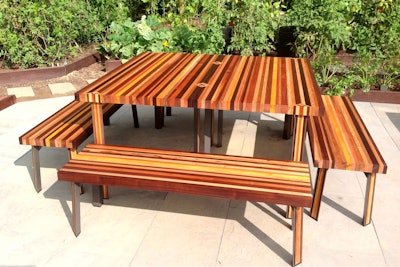 The table was built by UVA alumnus Roger Sherry out of various American woods.
The table was built by UVA alumnus Roger Sherry out of various American woods.Photo: Roger Sherry
The designs were presented in June and architecture student Owen Weinstein’s concept of incorporating the motto of “e pluribus unum – out of many, one” into every element of the design was selected.
“We used many different woods and different structural systems, including structures that combine steel and wood, which have different structural properties but come together to create something much stronger,” Meyer said. “We sensed that the first lady’s staff really like the idea, both for its aesthetic as well as its political and social associations.”
Following this “e pluribus unum” mindset, the team created an arbor to mark the path to the gathering area, and custom tables and benches out of a variety of American woods.
The American wood came from other historic locations, including Thomas Jefferson’s Monticello, James Madison’s Montpelier, James Monroe’s home at Ash Lawn-Highland, and Martin Luther King’s birthplace in Atlanta.
“Each piece has so many really interesting and historical and geographical stories attached to it,” Meyer said.
It was then constructed by landscape architect and master builder Roger Sherry, a 1998 graduate of UVA’s architecture school. The botanical and common names of the woods were etched into one of the benches highlighting the wide geographical origins of the woods.
“The different materials come together and become stronger and more beautiful in the process, which seemed to us quite a nice metaphor,” Weinstein said. “We used wood from throughout the United States, so you have a sampling of American woods with really tremendous variety in grain, tone and texture, all lined up next to each other to become this beautiful assembly.”
Along with the new garden elements, the team also assembled a short report on the history of kitchen gardens at the White House. The finished project was unveiled on Wednesday, October 5, and Michelle Obama thanked the team for their work.
“I take great pride in knowing that this little garden will live on as a symbol of the hopes that we all hold of growing a healthier nation for our children,” the first lady said. “I am hopeful that future first families will cherish this garden like we have.”
